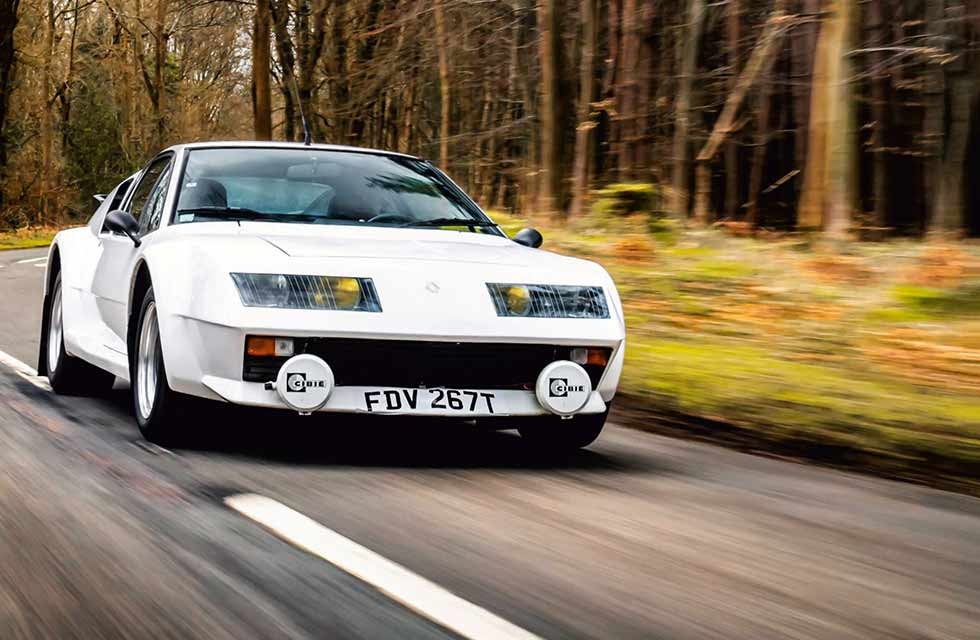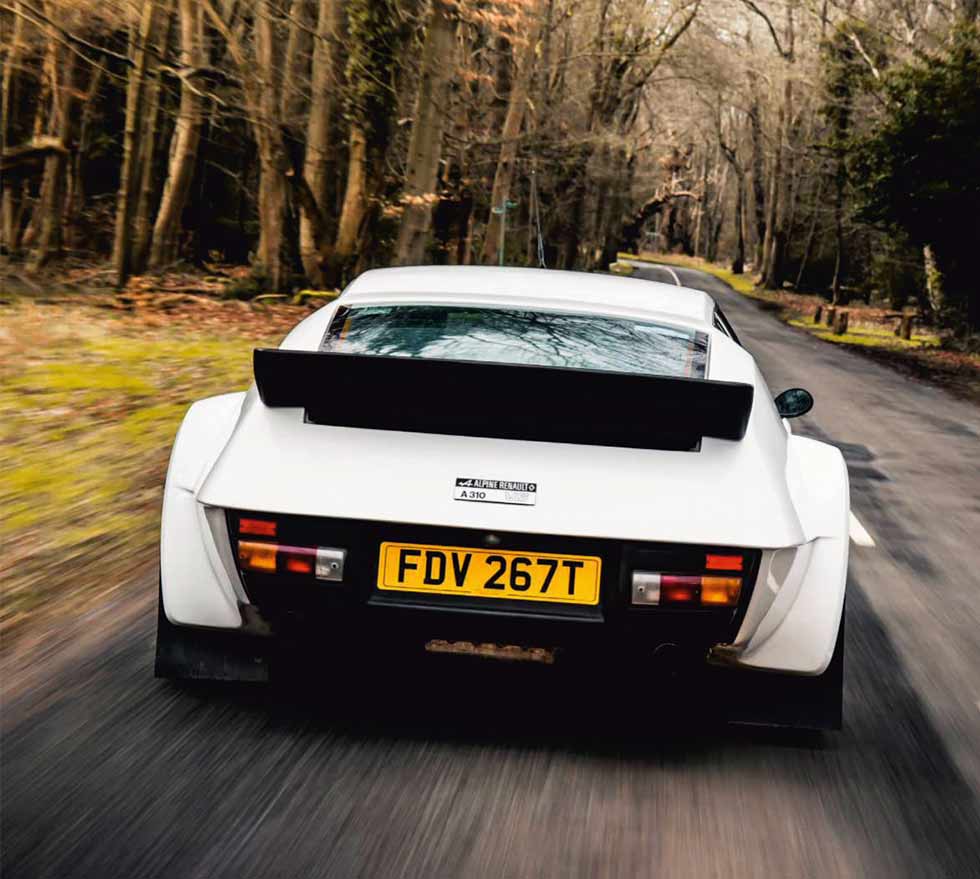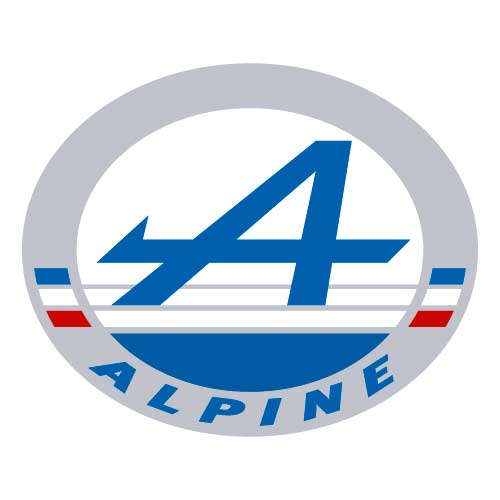
Could the Alpine A310GT have countered the Lancia Stratos and 037? Find out here. Alpine’s A310GT could have been a rallying colossus. Instead it’s a curious footnote, but why? We take a rare example for a drive and reveal all. Words Sam Dawson. Photography Jonathan Fleetwood.
Should the rare Alpine A310GT have conquered the world?
A For Effort Charging through the Chilterns in Renault’s forgotten Group B rally weapon – the Alpine A310GT. Did it deserve a better fate?
If it weren’t for a tuning firm tinkering with a Renault 5, it’s entirely possible that the Alpine A310GT you see here would be as instantly recognisable – and quite possibly as successful – as the Lancia Stratos. Kids would have posters of Calberson-liveried rally versions on their bedroom walls, Renault would be recreating it rather than the tribute A110, and most Group B rally contenders might have ended up as sleek coupés rather than silhouette-body hatchbacks. It had all the ingredients and pedigree for greatness, and yet it’s been relegated to curio status. Why?

Like so many Seventies supercars, the massive wheelarch extensions were part of a Group 4 homologation overhaul intended to accommodate a new kind of motor sport-bred tyre – in this case, the Pirelli P7. Hinge up the rear windscreen, remove the air filter, and a thoroughbred-looking layout is revealed – an all-alloy wide-angle 2.7-litre V6 directly related to a Le Mans-winner and fed by a bizarre-looking combination of single- and twin-choke Solex carburettors, hanging longitudinally from a steel backbone chassis. I could be looking at the innards of a modified Lotus Esprit, and yet a glance from the side of the car reveals just how short the wheelbase is – 89.3 inches – putting that big six-cylinder defiantly behind the rear axle point.
‘Brake too hard and those vast tyres might suddenly behave like curling stones’

‘Alpine found another role for the A310 V6 – as a privateer Group B rally car’
The A310’s Trevor Fiore-penned lines promoted with jet-setting brochure imagery make it out to be a sophisticated Maserati Merak-type all-rounder, exotic styling combined with two-plus-two practicality and a dash of luxury in the leather embrace of its seats. But the raw materials speak of a different purpose. Short wheelbase, lightweight glassfibre construction and rear-biased weight distribution usually results in something that flips through 180 degrees with ease in the middle of a hairpin bend, and can be flicked sideways telepathically – provided the steering’s nervous enough – on gravel. All the hallmarks of a pre-Audi-Quattro Group 4 rally machine. Something to succeed the once-peerless little A110 in a more brutish, power-crazed era. A counter to the mighty Lancia Stratos and Porsche 911.
With those cars in mind, sliding aboard definitely puts me more in mind of the Stratos. It feels incredibly compact, even more so once the flimsy plastic door is shut, the window’s edge mere inches from my shoulder. My knees have to negotiate a low-set wheel, and once ensconced, although I’m comfortably reclined, there’s a noticeable skew in both pedals and steering column towards the centre of the car, as though it started out as a single-seater and was massaged into practicality as an afterthought. Speaking of practicality, that leather-clad cubbyhole of a rear seating bench is as useless as an MG BGT’s, even so far as children are concerned, but given that there’s no boot – and that a full-size spare wheel occupies the front storage compartment – it functions as the A310’s de facto boot space.
The unassisted steering is a full three and a half turns lock-to-lock, which doesn’t sounds particularly sporty, but it is. There’s very little weight over the nose, and the turning circle is very tight for a sports car with 205-section tyres up front. It also doesn’t take long to realise quite how alert, direct and free of slack the steering is. On full lock it’ll negotiate a cramped car park or climb an ultra-tight mountain hairpin bend with ease, but the vast majority of bends can be taken with your hands fixed at quarter-to-three as the finest race-bred machines should.
And all the while, it manages to balance a sense of fine communication with smoothness, eddies in the tarmac translating into little twitches of the wheel rather than brutal wrenches. I’m having a hard time thinking of another contemporary sports car with steering so pure. A Lotus Esprit has the feedback but not the lock; A Porsche 911 marries its wieldiness with tiring information overload. This level of control and tactility is a defining Alpine trait, cropping up as it does in the earlier A110 and later GTA too. Other elements of the drive carry this sense of compliance.
The gear-change is long-throw but moves as silkily as a warm knife through chocolate cake. The ride is also impressive, the combination of wishbones and transverse links on each corner, long-travel dampers and high-sidewall tyres absorbing ruts like an executive saloon while tightly maintaining body control. The alert steering keeps me informed of road-surface imperfections, but the suspension ensures the car won’t be thrown off-course. The engine, too, suggests sophistication.
Although the big wheelarches, side-skirts and spoilers – and the fact the Group 4 A310 V6 blitzed the French Rally Championship straight out of development in 1977 – suggest something violently quick and unashamedly unrefined, the Peugeot-Renault-Volvo V6 – devised to propel leather-clad luxo-barges as well as Le Mans prototypes – is as urbane as the rest of the car.
There’s a slight crackle on ignition, then it settles to a whisper at idle. Accelerate hard, and there are no sudden jolts of power, just an escalating wave of torque. Exhaust sibilance turns to snarl at around 3000rpm, but even then it’s muted from the perspective of the cabin; one of the advantages of a rear-mounted engine means all the noise is left behind you.
I’m mindful of that 37/63 rear-biased weight distribution as I attack a sequence of Chiltern forest bends, preparing for the car to wander under braking and threaten tail-happiness if corners are taken with too much speed. A vicious downhill hairpin, tighter than it first looked, throws up a challenge to the A310GT’s dynamics, but its attitude through the corner is more like a mid- than a rear-engined car.
It’s down to the incredible grip summoned by those bulbous 225/45 VR15 rear tyres. Pick up speed through complexes of corners, and you soon learn to put faith in their stickiness. Combined with the incredible steering, capable of winding on such tight angles, the car can be placed with fine precision. The only factor that doesn’t quite gel is the braking system.
With very little pedal travel or feel, the required technique is like slowing a less responsive Citroën DS – reading the road, thinking ahead and leaning firmly but progressively on the unyielding metal underfoot. It’s at this point, on a wet road, that the A310GT might finally reveal the shortcomings of its rear-engined layout. It feels as though pressing the unprogressive pedal too hard might lock the brakes, making those vast tyres suddenly let go and behave like curling stones. But that’s not something that would trouble a skilled rally driver, and the braking system could be easily adjusted by their service crew.
So if it manages to combine the best elements of cars like the Lancia Stratos and Porsche 911 – both titans of Seventies rallying – while being so controllable, and has the French Championship results to prove its prowess, why didn’t it make the same kind of mark on the World Rally Championship that its rivals – and A110 predecessor – managed?
The reason lies in Renault company politics, and a seismic moment in World Rallying that’s been forgotten since, and wasn’t really noticed by the British press. In the wake of the 1973 international oil crisis, Renault bought both Alpine – manufacturer of Renault-engined sports cars since 1959 – and Gordini, the Renault performance-tuner and engine-design specialist. Although Alpine already used Gordini-tuned engines, the relationship within what would eventually become RenaultSport was formalised. Gordini was to be the competition department, and Alpine would build Renault’s low-volume sports cars, even if the mechanicals were fundamentally Gordini.
On a visit to Alpine’s Dieppe factory to evaluate the new four-cylinder version of the A310 in 1974 and check out the V6 prototype, CAR’s Mel Nichols spotted a Gordini side-project lurking in a corner – which turned out to be a Renault 5 packing a then-astonishing 160bhp from a mere 1397cc, brought about by increased compression and Weber carburetion.
Although it was barely noticed here, early road-testing of this prototype prompted a similar reaction in France to the one the Lotus Carlton generated in the UK in the late Eighties – the press was aghast, branding the tweaked 5 irresponsible and dangerous. But as per the Carlton, the French public fell in love with the concept. By 1976 this car was available to buy as the Renault 5 Alpine (more correctly badged Gordini in the UK, where the right to use the Alpine name was owned by Chrysler) – admittedly downtuned to 93bhp, but easily whacked back up for motor sport use. It quickly picked up a nickname – ‘le skateboard’ – and comparisons with the Mini Cooper. And then, the snow-stricken 1978 Monte Carlo Rally happened.
Fresh from the model’s crushing victory in the 1977 French Rally Championship, the Alpine A310 V6s of Paul Rouby/Jean-Louis Martin and Olivier Lamirault/Christian Gilbert lined up against the Group 4 opposition – Lancia Stratoses, Porsche 911s and Fiat 131 Abarths. Yet all but the Porsche 911 of Jean-Pierre Nicolas/Vincent Laverne would be humbled by a pair of 1.4-litre Renault 5 Alpines, driven by Jean Ragnotti and Guy Fréquelin to second and third place. Ragnotti was less than two minutes shy of the winning Porsche by the end of the rally.
The best-placed A310 was the Rouby/Martin car, far adrift in 17th. With both 131s and Stratoses kept from the podium apparently by lowly superminis, the Italian press labelled the rally a national humiliation. But quietly, it had been sobering for Alpine as a builder of sports cars, as opposed to assembler of special-edition Renaults, as well.
Although the Audi Quattro is seen as the revolution that changed rallying forever with its four-wheel drive, in reality it was one side of a simultaneous equation. On the other was the concept of getting a huge amount of power from a comparatively small, lightweight engine and mounting it within the wheelbase of something that looked like a mass-produced supermini. And Gordini, which followed the 1978 Monte Carlo victory with a Le Mans 24 Hours win by a turbocharged 2.0-litre V6, then the first forced-induction Formula One win with just 1.5 litres in a field full of 3.0-litre V8s at the French Grand Prix the following year, knew this solution lay in turbocharging the 5 Alpine’s four-cylinder, increasing its compression even further.
Back in 1974, Gordini managing director Jean Terramorsi bullishly told Mel Nichols, ‘First Ferrari was superior, then Cosworth, and in the future it is going to be Renault. In the next ten years, Renault is going to be the one to beat.’ He wasn’t just referring to Formula One engines – he harboured a desire to build something to defeat the Ferrari-engined Lancia Stratos and Cosworth-powered Ford Escort on the rally stages too. And the result of the 1978 Monte Carlo Rally suggested the solution lay in the wheel-at-each-corner Renault 5 rather than the tail-engined Alpine A310. The fact that rally victories could cast a halo effect over a mass-produced shopping-car range only pleased Renault top brass further. This thinking resulted in the Renault 5 Turbo, and Monte Carlo victory with Ragnotti in 1981 – the car’s first rally. The Audi Quattro scored its first win with Michèle Mouton in Sanremo nine months later. The ingredients for the Group B rally car were identified, and the A310 V6 didn’t have them.
But Alpine found another role for the A310 V6, which as a road car was selling slowly and provincially against the more polished, global Porsche 911 – a privateer Group B rally car to slot in between the mass-produced 5 Alpine and the special-order 5 Turbo. From February 1982, the car could be ordered with the ‘GT Pack’, a collection of Group B-homologated modifications and add-ons including a completely remoulded Fleschmann-fabricated body incorporating wheelarch extensions, carried on exclusive Alpine-Fleschmann-branded Nogano alloy wheels. The Solex 35 CEEI twin-choke downdraught carburettor was joined by an additional 34 TBIA single-choke item on a special induction manifold, resulting in a choke per two cylinders. The GT Pack – Group B Homologation number B-204 – could be retrospectively applied to existing A310 V6s.
This one started out as a standard car in 1978 before being turned into a GT at the behest of its Parisian owner, who also added the stopwatches, Halda Tripmaster and plumbed-in engine-bay fire-extinguisher for rallying; but post-1981 examples also shared some developments with the 5 Turbo, including its rear suspension, hubs and wheels. Sadly, it failed to make much of an impact even in this junior role. At FF105,000 to the 5 Turbo’s FF115,000, it wasn’t cheap enough and the marketing effort was half-hearted. The Garrett-boosted 5 continued to rule Gallic asphalt stages.
And yet, the A310GT did manage to play a different role, perhaps unexpected when its rally-car modifications were devised. In 1976, Renault had bought into the US market via a partnership with AMC. One of the alliance’s dealer principals, Mike Parmekian, had a history of grey-importing European supercars into the US, and reckoned the A310GT could have another lease of life as a Porsche 911 competitor in the US. He added a twin triple-choke Weber carburettor setup, pumping power up to 193bhp from 150.
In its final two years, and with no official marketing, the Alpine A310GT picked up a cult following in the US. Only small numbers were imported – at $28,800 it was more expensive than the $27,250 Porsche 911 Turbo – but the press response was rapturous. Sports Car Graphic declared it superior to the Porsche and more worthy of comparison to the $47,440 Ferrari 308 GTBi, although Motor Trend questioned its refinement and finish for the price, especially because Parmekian’s 193bhp version cost an additional $6000.
Renault took notice of praise like this, and for 1986, embracing the reliable potential of its worldwide dealer network, reskinned and reworked the wide-track rally-bred A310GT as the smoother, more sophisticated road-focused GTA, pitched directly at Porsche and destined for a decade in production. As RenaultSport absorbed the marque’s rallying role, Alpine’s future lay in slick, road-focused supercars. But without the brutish-sophisticate A310GT to act as a bridge between these eras, would the marque still exist as we know it today?
TECHNICAL DATA FILE SPECIFICATIONS 1978 Alpine A310GT
Engine 2664cc V6, sohc per bank, one Solex 35 CEEI & one Solex 34 TBIA carburettor
Max Power 150bhp @ 6000rpm
Max Torque 151lb ft @ 3500rpm
Transmission Five-speed manual, rear-wheel drive
Steering Rack and pinion Suspension Front and rear: independent, wishbones, transverse links, coil springs, telescopic dampers, anti-roll bar
Brakes Servo-assisted discs front and rear
Weight 1015kg
Performance Top speed: 137mph;
0-60mph: 7.4sec
Fuel consumption 31mpg
Cost new FF105,000 (1978 FR)
CC Price Guide £19k-£36.5k (standard A310 V6 / 2019 UK)
Alpine-Fleschmann Nogano alloys were made exclusively for the GT Pack by PLS Provisions for cooling the rear-mounted V6 are minimal. The unrelenting grip of the 225-section rear tyres counters the pendulous placement of the V6 Engine bay was originally planned to hold a flat-packed, deflated-tyre spare wheel The novel induction manifold boasts both single- and twin-choke Solex carburettors. Among the best steering in the business, says Sam.
OWNING THE ALPINE A310GT
‘It’s lived a colourful life,’ says artist Wolf Sulhan of his Alpine A310GT, ‘and has been shipped all over the world by previous owners, from Paris to Hong Kong. It has an unusual history too, because it appears it was originally built in 1978 as a standard V6, and re-shelled and modified by Alpine a few years later when the GT Pack became available.
The interior options – the plumbed-in fire extinguisher, rally-meter and stopwatches – suggest it was used for privateer rallying in France too. I’m currently trying to trace its competition history.
‘I love its aesthetics, and also the practicality and ruggedness of its design. Glassfibre doesn’t rust, so it happily lives outside under a car cover. It is prone to running hot though, not helped by the lack of ducting and vents in the engine bay – a surprising design flaw, really – so I’ve had to add a manually-switchable cooling fan.’






